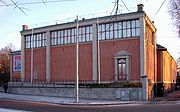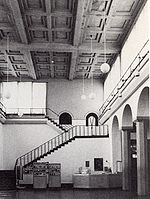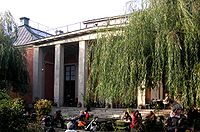
Liljevalchs konsthall
Encyclopedia


Art gallery
An art gallery or art museum is a building or space for the exhibition of art, usually visual art.Museums can be public or private, but what distinguishes a museum is the ownership of a collection...
located on the Djurgården island in Stockholm
Stockholm
Stockholm is the capital and the largest city of Sweden and constitutes the most populated urban area in Scandinavia. Stockholm is the most populous city in Sweden, with a population of 851,155 in the municipality , 1.37 million in the urban area , and around 2.1 million in the metropolitan area...
, Sweden
Sweden
Sweden , officially the Kingdom of Sweden , is a Nordic country on the Scandinavian Peninsula in Northern Europe. Sweden borders with Norway and Finland and is connected to Denmark by a bridge-tunnel across the Öresund....
. Designed by architect Carl Bergsten (1879–1935) and inaugurated in March 1916, it is today owned by the City of Stockholm
Stockholm
Stockholm is the capital and the largest city of Sweden and constitutes the most populated urban area in Scandinavia. Stockholm is the most populous city in Sweden, with a population of 851,155 in the municipality , 1.37 million in the urban area , and around 2.1 million in the metropolitan area...
.
Behind the entrance on the north-western corner is a small vestibule. To the right of the latter is a large sculpture hall leading to two large galleries with skylights intended for paintings, flanked by series of smaller exhibition spaces. The eastern end of the building has a large-scale portico facing a small park surrounded by the large windows of a small restaurant.
One of the most appreciated exhibition spaces in Sweden, Liljevalch is renowned for its well-proportioned spaces in a range of sizes and its restaurant Blå porten ("Blue Gate"). The concrete pillars and beams forming the structural framework of the building are left exposed as pilaster
Pilaster
A pilaster is a slightly-projecting column built into or applied to the face of a wall. Most commonly flattened or rectangular in form, pilasters can also take a half-round form or the shape of any type of column, including tortile....
s and moulding
Molding (decorative)
Molding or moulding is a strip of material with various profiles used to cover transitions between surfaces or for decoration. It is traditionally made from solid milled wood or plaster but may be made from plastic or reformed wood...
s in the façade with brick walls and a horizontal row of windows filling the spaces between them. In front of and above the main entrance is a sculpture and a relief by Carl Milles
Carl Milles
Carl Milles was a Swedish sculptor, best known for his fountains. He was married to artist Olga Milles and brother to Ruth Milles and half brother to the architect Evert Milles...
.
History

Art Nouveau
Art Nouveau is an international philosophy and style of art, architecture and applied art—especially the decorative arts—that were most popular during 1890–1910. The name "Art Nouveau" is French for "new art"...
architect Otto Wagner
Otto Wagner
Otto Koloman Wagner was an Austrian architect and urban planner, known for his lasting impact on the appearance of his home town Vienna, to which he contributed many landmarks.-Life:...
. After a trip through continental Europe in 1907, he instead became inspired by traditional architecture, especially in Turkey and Denmark. When Bergsten won the competition for the art gallery in 1913, he had thus given up his early experimental style to embrace a Classicism
Classicism
Classicism, in the arts, refers generally to a high regard for classical antiquity, as setting standards for taste which the classicists seek to emulate. The art of classicism typically seeks to be formal and restrained: of the Discobolus Sir Kenneth Clark observed, "if we object to his restraint...
which he combined with his preference for reduced volumes and modern concrete construction techniques. Bergsten always had a constructive approach to architecture and at Liljevalch his design used basic functional demands as a departure point to create series of multi-purpose spaces. Several details, including the large stairs of the sculpture hall, suggest an inspiration from Heinrich Tessenow
Heinrich Tessenow
Heinrich Tessenow was a German architect, professor, and urban planner active in the Weimar era.-Biography:...
's rational Classicism where light is used to emphasis simple sculptural volumes. While the indoor courtyard was also used at this time by Ragnar Östberg
Ragnar Östberg
Ragnar Östberg was a Swedish architect who is most famous for designing Stockholm City Hall. He is the most famous architect within the so-called "national romanticist" movement in Sweden...
at the "Blue Hall" in the Stockholm City Hall
Stockholm City Hall
Stockholm City Hall is the building of the Municipal Council for the City of Stockholm in Sweden. It stands on the eastern tip of Kungsholmen island, next to Riddarfjärden's northern shore and facing the islands of Riddarholmen and Södermalm. It houses offices and conference rooms as well as...
, at Liljevalch Bergsten managed to combine traditional details with the newest concrete construction technique, and the art gallery was thus a forerunner to the modern architecture still to come.

Neoclassicism
Neoclassicism is the name given to Western movements in the decorative and visual arts, literature, theatre, music, and architecture that draw inspiration from the "classical" art and culture of Ancient Greece or Ancient Rome...
but becomes "classical" by confining itself to simplicity and honesty as a constructive principle.
External links
- Liljevalchs konsthall (official site)

